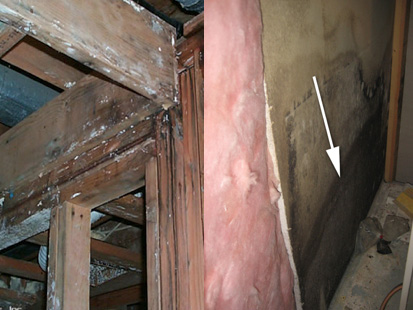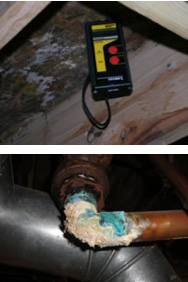Suffolk: 631-205-1340 | Nassau: 516-822-0827 | Outside Long Island: 1-888-886-1958
|
|
||
 |
||
|
|
||
|
|
|
|
|
Mold
Molds are a type of fungi found throughout the natural environment. Fungi are a large and diverse class of microorganisms that live on organic nutrients. In nature, they play an important role in the breakdown of dead organic matter. Certain varieties of fungal spores contain mycotoxins (fungal toxins) which we can breathe. Pathogenic or toxic molds can cause serious health effects – especially in persons with decreased immune function or life threatening disease. Molds become problematic when they are found in excessive amounts in the indoor environment. Like most fungi, the majority of molds reproduce by producing spores in large numbers in the fruiting bodies. These microscopic spores develop on hyphae (threadlike filaments) that project up into the air above the food source, thus making them easily airborne. Because they are so small, mold spores can be carried indoors on clothing, pets, and shoes, or enter through open doors, windows, and ventilation systems. It is impossible and impractical to attempt to eliminate all indoor molds, but it is necessary to prevent their significant accumulation and growth. In order to grow and survive, molds need moisture, a nutrient base, and a temperature range between 40 – 100 degrees Fahrenheit. Under the right conditions, spores can feed on wood, paper, carpet, soil, plants and fabrics. Any dirt on these surfaces can provide additional nutrients for spore growth. Frequently Asked Questions About Mold What kind of mold is in my house – is it toxic mold? How did the mold get into my home? How can I tell if there is mold in my home? How can I stop mold from growing in my home? Moisture Evaluation
We offer our clients a moisture evaluation. In this evaluation, a visual inspection of the building is augmented by moisture meter readings to map out the source of moisture intrusion. A moisture evaluation commences with an exterior inspection to identify construction defects and neglected maintenance issues which can render the exterior envelope vulnerable to water intrusion. Also included are identification of roof damage, roof and surface drainage, and malfunctioning lawn water sprinklers. Interior issues such as plumbing defects and water leaks, HVAC system operation, chronic condensation caused by inadequate insulation and intrusion of humid outdoor air into the dwelling are included in the evaluation. A report is issued to the client along with digital photographs highlighting the deficiencies found along with recommendations for corrective action. After the moisture has been identified and eliminated then remediation can proceed. This is a necessary step in the quest to improve overall indoor air quality. Mold colonies, often unseen, can develop and grow inside wall cavities, crawlspaces, furnishings and plants and almost any area of a home. They release their spores into the air we breath the spores can also be absorbed into our eyes, nose, throat and lungs. It is estimated that approximately 30 % of us are allergic to mold and suffer adverse health effects because of it. The United States environmental protection agency recommends that every home in America be tested for certain environmental pollutants, regardless of age, location or style of your home. You and your family may be exposed to hazardous levels of contaminants 10 to 20 times greater then found outdoors and without knowing why, experience systems that are often overlooked by doctors as everyday medical complaints. Even if everyone in your family feels great, it is still recommended that you test your home to prevent health problems before they occur. Mold requires moisture and organic matter to feed upon. High relative humidities are required for germination and growth while lower humidities tend to increase the release of mold spores as a method for self-preservation. CONTAMINATED CENTRAL AIR HANDLING SYSTEMS CAN EASILY BECOME BREEDING GROUNDS FOR MOLD. Mold exposure systems that can and are often over looked by people and physicians as common, everyday medical complaints include:
If you suspect exposure, seek help of a qualified physician immediately and have your home or work place tested as soon as possible by an environmental specialist like AC&E. Our mold testing goes beyond just the testing phase. We come in, determine what is happening and why, and offer solutions to correct the problem. Samples are taken and sent to the lab, thermal imaging is performed to scan for moisture behind walls, moisture meter readings are taken and a report is written which specifies what needs to be done. All Lab Work Done By AIHA (American Industrial Hygiene Association) Accredited Lab. |
||
|
|
|
|
|
|
||

 Molds can cause serious health effects!
Molds can cause serious health effects!